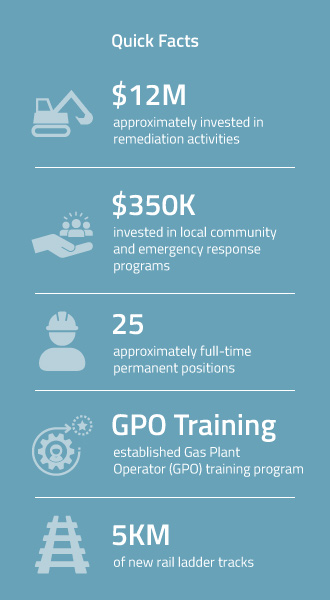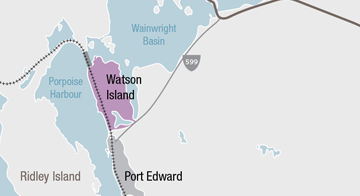
Prince Rupert Terminal
There is no on-site processing or refrigeration, and the terminal is limited to handling and storage.
The facility is comprised of approximately 5 kilometres of new rail ladder tracks and three above-ground propane storage spheres. Propane is offloaded and stored at the rail terminal following delivery by CN via its existing rail lines. The terminal is expected to operate at 20,000 barrels per day with a capacity of 25,000 barrels per day. Propane is the only product that Pembina plans to handle at the facility. The propane is extracted off site from natural gas supply in northern BC and Alberta and will be transported from our Redwater Complex northeast of Edmonton to Prince Rupert by rail. The project capital budget was $250 million.
The Prince Rupert Terminal came into service in 2021. Dry commissioning was completed in March and Pembina began loading propane onto vessels destined for international markets in April. The start-up of this facility is a major step in providing new market solutions and helping add incremental value to Western Canadian hydrocarbons.
Pembina’s propane export terminal in the Prince Rupert area is a welcome investment in our province. I am glad to see companies like Pembina finding ways to repurpose land to deliver sustainable development solutions. The project is creating local jobs and enhancing partnerships in the North Coast that will benefit local and Indigenous communities for decades to come.
Licenced Capacity: 25,000 bbls/d
Fuel type: Propane
Rules & Notice to ships
Green Marine, February 13, 2023
Pembina Pipeline Corporation’s Prince Rupert Terminal is the newest participant in Green Marine – the leading voluntary environmental certification program for North America's maritime industry. Learn more.
View news releases for more information.

"The face-to-face learning distinguished this program and boosted the ability of students to master new information. It’s been great to see the program participants gain confidence in their skill sets and continue to build their knowledge at the new terminal." - Tara J. Leighton, Employment Coordinator, Metlakatla First Nation
Liquefied petroleum gas (LPG) is derived from the family of light hydrocarbons, called natural gas liquids (NGL). Recognized for its low environmental impact, propane is one of the cleanest and most versatile fuels in existence. At normal atmospheric pressure and temperatures above minus 42 degrees Celsius, propane is a non-toxic colourless and odourless gas. It becomes a liquid when cooled and pressurized. Propane is stored and transported as a liquid and doesn’t become a gas until it is used.
Common uses include household heating, cooking, barbeques and power generation.

